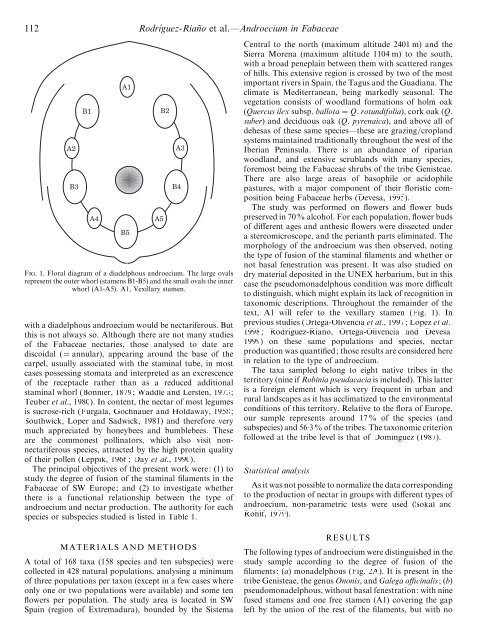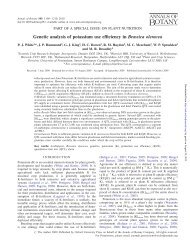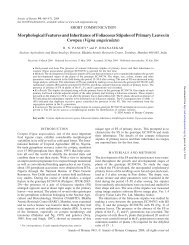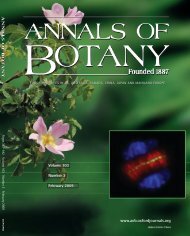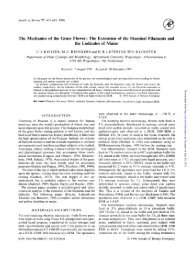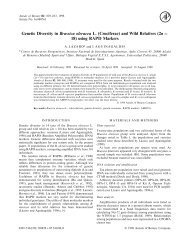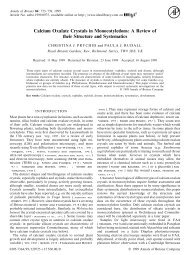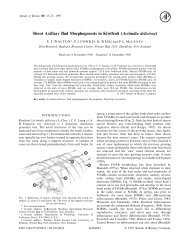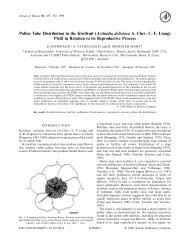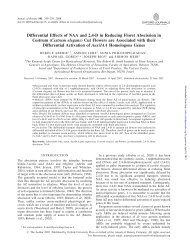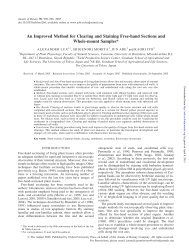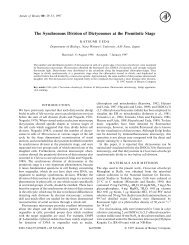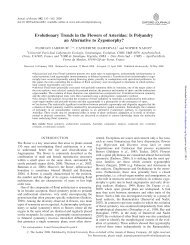Types of Androecium in the Fabaceae of SW ... - Annals of Botany
Types of Androecium in the Fabaceae of SW ... - Annals of Botany
Types of Androecium in the Fabaceae of SW ... - Annals of Botany
Create successful ePaper yourself
Turn your PDF publications into a flip-book with our unique Google optimized e-Paper software.
112 Rodrıguez-Rian o et al.—<strong>Androecium</strong> <strong>in</strong> <strong>Fabaceae</strong><br />
A2<br />
B3<br />
B1<br />
A4<br />
A1<br />
B5<br />
Fig. 1. Floral diagram <strong>of</strong> a diadelphous androecium. The large ovals<br />
represent <strong>the</strong> outer whorl (stamens B1-B5) and <strong>the</strong> small ovals <strong>the</strong> <strong>in</strong>ner<br />
whorl (A1-A5). A1, Vexillary stamen.<br />
with a diadelphous androecium would be nectariferous. But<br />
this is not always so. Although <strong>the</strong>re are not many studies<br />
<strong>of</strong> <strong>the</strong> <strong>Fabaceae</strong> nectaries, those analysed to date are<br />
discoidal ( annular), appear<strong>in</strong>g around <strong>the</strong> base <strong>of</strong> <strong>the</strong><br />
carpel, usually associated with <strong>the</strong> stam<strong>in</strong>al tube, <strong>in</strong> most<br />
cases possess<strong>in</strong>g stomata and <strong>in</strong>terpreted as an excrescence<br />
<strong>of</strong> <strong>the</strong> receptacle ra<strong>the</strong>r than as a reduced additional<br />
stam<strong>in</strong>al whorl (Bonnier, 1879; Waddle and Lersten, 1973;<br />
Teuber et al., 1980). In content, <strong>the</strong> nectar <strong>of</strong> most legumes<br />
is sucrose-rich (Furgala, Gochnauer and Holdaway, 1958;<br />
Southwick, Loper and Sadwick, 1981) and <strong>the</strong>refore very<br />
much appreciated by honeybees and bumblebees. These<br />
are <strong>the</strong> commonest poll<strong>in</strong>ators, which also visit nonnectariferous<br />
species, attracted by <strong>the</strong> high prote<strong>in</strong> quality<br />
<strong>of</strong> <strong>the</strong>ir pollen (Leppik, 1966; Day et al., 1990).<br />
The pr<strong>in</strong>cipal objectives <strong>of</strong> <strong>the</strong> present work were: (1) to<br />
study <strong>the</strong> degree <strong>of</strong> fusion <strong>of</strong> <strong>the</strong> stam<strong>in</strong>al filaments <strong>in</strong> <strong>the</strong><br />
<strong>Fabaceae</strong> <strong>of</strong> <strong>SW</strong> Europe; and (2) to <strong>in</strong>vestigate whe<strong>the</strong>r<br />
<strong>the</strong>re is a functional relationship between <strong>the</strong> type <strong>of</strong><br />
androecium and nectar production. The authority for each<br />
species or subspecies studied is listed <strong>in</strong> Table 1.<br />
MATERIALS AND METHODS<br />
A total <strong>of</strong> 168 taxa (158 species and ten subspecies) were<br />
collected <strong>in</strong> 428 natural populations, analys<strong>in</strong>g a m<strong>in</strong>imum<br />
<strong>of</strong> three populations per taxon (except <strong>in</strong> a few cases where<br />
only one or two populations were available) and some ten<br />
flowers per population. The study area is located <strong>in</strong> <strong>SW</strong><br />
Spa<strong>in</strong> (region <strong>of</strong> Extremadura), bounded by <strong>the</strong> Sistema<br />
A5<br />
B2<br />
A3<br />
B4<br />
Central to <strong>the</strong> north (maximum altitude 2401 m) and <strong>the</strong><br />
Sierra Morena (maximum altitude 1104 m) to <strong>the</strong> south,<br />
with a broad penepla<strong>in</strong> between <strong>the</strong>m with scattered ranges<br />
<strong>of</strong> hills. This extensive region is crossed by two <strong>of</strong> <strong>the</strong> most<br />
important rivers <strong>in</strong> Spa<strong>in</strong>, <strong>the</strong> Tagus and <strong>the</strong> Guadiana. The<br />
climate is Mediterranean, be<strong>in</strong>g markedly seasonal. The<br />
vegetation consists <strong>of</strong> woodland formations <strong>of</strong> holm oak<br />
(Quercus ilex subsp. ballota Q. rotundifolia), cork oak (Q.<br />
suber) and deciduous oak (Q. pyrenaica), and above all <strong>of</strong><br />
dehesas <strong>of</strong> <strong>the</strong>se same species—<strong>the</strong>se are graz<strong>in</strong>gcropland<br />
systems ma<strong>in</strong>ta<strong>in</strong>ed traditionally throughout <strong>the</strong> west <strong>of</strong> <strong>the</strong><br />
Iberian Pen<strong>in</strong>sula. There is an abundance <strong>of</strong> riparian<br />
woodland, and extensive scrublands with many species,<br />
foremost be<strong>in</strong>g <strong>the</strong> <strong>Fabaceae</strong> shrubs <strong>of</strong> <strong>the</strong> tribe Genisteae.<br />
There are also large areas <strong>of</strong> basophile or acidophile<br />
pastures, with a major component <strong>of</strong> <strong>the</strong>ir floristic composition<br />
be<strong>in</strong>g <strong>Fabaceae</strong> herbs (Devesa, 1995).<br />
The study was performed on flowers and flower buds<br />
preserved <strong>in</strong> 70% alcohol. For each population, flower buds<br />
<strong>of</strong> different ages and an<strong>the</strong>sic flowers were dissected under<br />
a stereomicroscope, and <strong>the</strong> perianth parts elim<strong>in</strong>ated. The<br />
morphology <strong>of</strong> <strong>the</strong> androecium was <strong>the</strong>n observed, not<strong>in</strong>g<br />
<strong>the</strong> type <strong>of</strong> fusion <strong>of</strong> <strong>the</strong> stam<strong>in</strong>al filaments and whe<strong>the</strong>r or<br />
not basal fenestration was present. It was also studied on<br />
dry material deposited <strong>in</strong> <strong>the</strong> UNEX herbarium, but <strong>in</strong> this<br />
case <strong>the</strong> pseudomonadelphous condition was more difficult<br />
to dist<strong>in</strong>guish, which might expla<strong>in</strong> its lack <strong>of</strong> recognition <strong>in</strong><br />
taxonomic descriptions. Throughout <strong>the</strong> rema<strong>in</strong>der <strong>of</strong> <strong>the</strong><br />
text, A1 will refer to <strong>the</strong> vexillary stamen (Fig. 1). In<br />
previous studies (Ortega-Olivencia et al., 1997; Lo pez et al.,<br />
1998; Rodrıguez-Rian o, Ortega-Olivencia and Devesa,<br />
1999) on <strong>the</strong>se same populations and species, nectar<br />
production was quantified; those results are considered here<br />
<strong>in</strong> relation to <strong>the</strong> type <strong>of</strong> androecium.<br />
The taxa sampled belong to eight native tribes <strong>in</strong> <strong>the</strong><br />
territory (n<strong>in</strong>e if Rob<strong>in</strong>ia pseudacacia is <strong>in</strong>cluded). This latter<br />
is a foreign element which is very frequent <strong>in</strong> urban and<br />
rural landscapes as it has acclimatized to <strong>the</strong> environmental<br />
conditions <strong>of</strong> this territory. Relative to <strong>the</strong> flora <strong>of</strong> Europe,<br />
our sample represents around 17% <strong>of</strong> <strong>the</strong> species (and<br />
subspecies) and 563% <strong>of</strong> <strong>the</strong> tribes. The taxonomic criterion<br />
followed at <strong>the</strong> tribe level is that <strong>of</strong> Domınguez (1987).<br />
Statistical analysis<br />
As it was not possible to normalize <strong>the</strong> data correspond<strong>in</strong>g<br />
to <strong>the</strong> production <strong>of</strong> nectar <strong>in</strong> groups with different types <strong>of</strong><br />
androecium, non-parametric tests were used (Sokal and<br />
Rohlf, 1979).<br />
RESULTS<br />
The follow<strong>in</strong>g types <strong>of</strong> androecium were dist<strong>in</strong>guished <strong>in</strong> <strong>the</strong><br />
study sample accord<strong>in</strong>g to <strong>the</strong> degree <strong>of</strong> fusion <strong>of</strong> <strong>the</strong><br />
filaments: (a) monadelphous (Fig. 2A). It is present <strong>in</strong> <strong>the</strong><br />
tribe Genisteae, <strong>the</strong> genus Ononis, and Galega <strong>of</strong>fic<strong>in</strong>alis;(b)<br />
pseudomonadelphous, without basal fenestration: with n<strong>in</strong>e<br />
fused stamens and one free stamen (A1) cover<strong>in</strong>g <strong>the</strong> gap<br />
left by <strong>the</strong> union <strong>of</strong> <strong>the</strong> rest <strong>of</strong> <strong>the</strong> filaments, but with no


